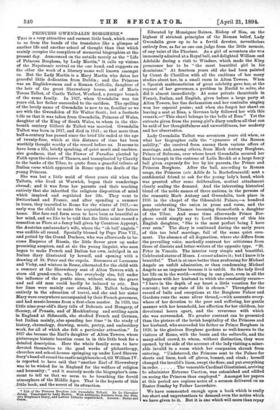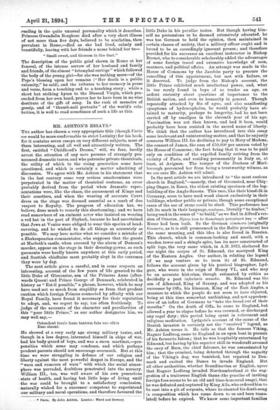PRINCESS GWENDALIN BORGHESE.* Tins is a very attractive and earnest
little book, which comes to us from the hands of the translator like a glimpse of another life and another school of thought than that which mainly occupies the compilers of memorial biographies at the present day. Announced on the outside merely as the "Life of Princess Borghese, by Lady Martin," it calls up visions of the Napoleonic revival on the one band, and suggests on the other the work of a literary name well known amongst us. But the Lady Martin is a Mary Martin who dates her graceful little dedication from Dublin ; and the Princess was an Englishwoman and a Roman Catholic, daughter of the heir of the great Shrewsbury house, and of Maria Teresa Talbot, of Castle Talbot, Wexford, a younger branch of the same family. In 1827, when Gwendalin was ten years old, her father succeeded to the earldom. The spelling of the lovely name of Gwendalin is new to us, familiar as we are with the Gwendolen of Sir Walter Scott; but a footnote tails us that it was taken from Gwendalin, Princess of Wales, daughter of the King of South Wales, to whom in the thir- teenth century Gilbert de Talbot was married. Gwendalin Talbot was born in 1817, and died in 1841; so that more than balf-a-century has passed since the brief life ended at the age of twenty-four, which at this distance of time has been worthily thought worthy of the record before us. It seems to have been a life, briefly speaking, of quiet merit and unobtru- sive goodness, that of the Flower of Paradise planted by Faith upon the shores of Thames, and transplanted by Charity to the banks of the Tiber, to quote from a graceful tribute of Italian verse which appeared in Rome upon the death of the young Princess.
She was but a little maid of three years old when the Talbots, who lived at Warwick, began their wanderings abroad ; and it was from her parents and their teaching entirely that she inherited the religious disposition of mind which inspired and regulated her life. They went to 'Switzerland and France, and after spending a summer in tours, they travelled to Rome for the winter of 1821,—so early was the child to make the acquaintance of her future home. Her face and form seem to have been as beautiful as 'her mind, and we like to be told that the little saint caused a -sensation as Flora at a fancy ball given by Countess Apponyi, the Austrian ambassador's wife, where the "oh bell' angiola " was audible all round. Specially blessed by Pope Pius VII., and petted by the Grand Duchess, who was afterwards to be- -come Empress of Russia, the little flower grew up under promising auspices, and at six the young linguist, who soon began to make French and Italian her own, indulged in an Italian diary illustrated by herself, and opening with a drawing of St. Peter and the cupola. Summers at Lausanne and Vichy, and winters in Rome, alternated for the child with a summer at the Shrewsbury seat of Alton Towers with a stern old grand-uncle, who, like everybody else, fell under the influence of the gentle niece, without whom the grave -and sad old man could hardly be induced to stir. But her lines were mainly cast abroad, Mr. Talbot believing -entirely in the education of travel, and she and her sister Mary were everywhere accompanied by their French governess, -and had music-lessons from a first-class master. In 1826, the little nine-year-old's diary tells of Bohemia and Hungary, of Saxony, of Prussia, and of Mecklenburg and settling again in England at Sidmouth, she studied French and German, but Italian mainly, also spending her time "in the study of history, chronology, drawing, music, poetry, and embroidery work, for all of which she felt a particular attraction." In 1827 she became the Earl's daughter of Alton Towers, whose picturesque historic beauties come in in this little book for a detailed description. Here the whole family seem to have -devoted themselves to the good works of philanthropy, -churches and school-houses springing up under Lord Shrews- bury's hand all round the castle neighbourhood, till William IV.
• is reported to have said that "another Earl of Shrewsbury was to be wished for in England for the welfare of religion • -and humanity ; " and it scarcely needs the biographer's com- ment to tell us that we seem to be breathing the fervid atmosphere of the Middle Ages. That is the keynote of this little book, and the secret of its attraction.
* Life of the Princess Borgheee (nle Grivendalin Talbot). By Le Chevalier .Zeloni. Translated by Lady Martin. With Additions, Extracts from the Prin- M8 Borghese's Diary, and Letters hitherto unpublished. London : Burns and Oates.
Educated by Monsignor Baines, Bishop of Sim, on the highest if strictest principles of the Roman belief, Lady Gwendalin grew up to be a fervid devotee, nevertheless entirely free, as far as one can judge from the little memoir, of any taint of the Pharisee. As a girl of seventeen she was immensely admired at a Royal ball, and delighted William and Adelaide during a visit to Windsor, which made the King pronounce her to be "the most beautiful girl in his dominions." At fourteen years old she had been painted by Count de Chatillon with all the emblems of her many studies about her, in a small room in Alton Towers. When a Spanish mathematician of great celebrity gave her, at the request of her governess, a problem in Euclid to solve, she did it almost immediately. At some private theatricals in French, Italian, and English, given before a large party at Alton Towers, her fine declamation and her contralto singing won her especial praise; and when she forgot her shawl on leaving a seat at Ems, a German lady followed her with this remark,—" This shawl belongs to the belle of Ems." Yet the extracts given from the young girl's diary confirm all that can be said of her thoughtfulness and unworldliness, her modesty and her observation.
Lady Gwendalin Talbot was seventeen years old when, as what her biographer calls the "cynosure of the Roman nobility," she received from among them various offers of marriage, and, among others, from Mark Antony Borghese, Prince of Sulmona, over whose heart Gwendalin secured her final triumph in the costume of Lalla Rookh at a large fancy ball given expressly for her by his parents, the Prince and Princess Borghese. After the ball, according to Roman usage, the Princess (nee Adele de la Rochefoucauld) sent a confidential friend to ask for the young lady's hand, which was granted after some deliberation, mutual attachment clearly sealing the demand. And the interesting historical blend of the noble names of three nations, in the persons of the romantic Mark Antony and Gwendalin, took place in 1835. in the chapel of the Odescalchi Palace,—a hundred pens celebrating the union in prose and verse, and the daughter of the Thames becoming thenceforth a daughter of the Tiber. And some time afterwards Prince Bor- ghese could simply say to Lord Shrewsbury of this his English daughter, "She is the most perfect being I have ever seen." The diary is continued during the early years of this too brief marriage, full of the same quiet com- ment. The absence of all dogmatism, where she differs from the prevailing voice, markedly contrast her criticisms from those of diarists and letter-writers of the opposite type. "St. Peter in Vincolo. The interior very simple and beautiful. Celebrated statue of Moses. I cannot admire it; but I know it is beautiful." That is at once better than professing for Michael Angelo an unfelt admiration, or than condemning Michael Angelo as an impostor because it is unfelt. So the lady lived her life on in the world—writing in one place, even in all the happiness with her husband to which she constantly recurs— "I have in the depth of my heart a little vocation for the convent; but my state of life is chosen." Throughout the record of balls and receptions at the Borghese Palace and Gardens runs the same silver thread,—with accounts every- where of her devotion to the poor and suffering, her gentle manner with her household, her affection for her children, her devotional hours apart, and the reverence with which she was surrounded. No greater contrast can be presented than the picture of the lavish hospitality of the Princess and her husband, who succeeded his father as Prince Borghese in 1839, in the glorious Borghese gardens so well-known to the visitors of Rome, with the boats and the saltarello, and the many-sided crowd, to whom, without distinction, they were opened, by the side of the account of the lady visiting a miser- able invalid in a room which her companion shrank from entering. "Undeterred, the Princess sent to the Palace for sheets and linen, took off gloves, bonnet, and. cloak; herself changed the invalid's linen, swept the floor, and put everything in order The venerable Cardinal Giustiniani, arriving to administer Extreme Unction, was astonished and edified on seeing the Princess thus employed." Amongst her papers at this period are copious notes of a sermon delivered on an Easter Sunday by Father Lacordaire.
We have commented enough upon a book which is really too short and unpretentious to demand even the notice which we have given to it. But it is one which will more than repay
reading in the quite unusual personality which it describes. Princess Gwendalin Borghese died after a very short illness of not more than five days, believed to be scarlatina, then prevalent in Rome,—died as she had lived, calmly and beautifully, leaving with her friends a name behind her to-
" Smell sweet, and blossom in the dust."
The description of the public grief shown in Rome at her funeral, of the intense sorrow of her husband and family and friends, of the almost "triumphal cortege" which followed -the body of the young girl—for she was nothing more—of the Pope's blessing upon her remains (" Her death is a public, calamity," be said), and the tributes to her memory in prose and verse, form a touching end to a touching story ; while a short but striking hymn to the Blessed Virgin, which pro- ceeded from her own hand, proves her to have been in no wise destitute of the gift of song. In the rush of memoirs of gossip, and of "thumb-nail portraits" of the world's cele- brities, it is well to read sometimes of such a life as this.



































 Previous page
Previous page